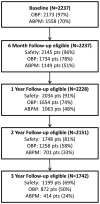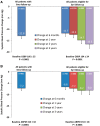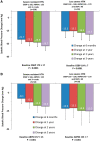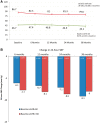Effects of renal denervation on kidney function and long-term outcomes: 3-year follow-up from the Global SYMPLICITY Registry
- PMID: 30907413
- PMCID: PMC6837160
- DOI: 10.1093/eurheartj/ehz118
Effects of renal denervation on kidney function and long-term outcomes: 3-year follow-up from the Global SYMPLICITY Registry
Abstract
Aims: Several studies and registries have demonstrated sustained reductions in blood pressure (BP) after renal denervation (RDN). The long-term safety and efficacy after RDN in real-world patients with uncontrolled hypertension, however, remains unknown. The objective of this study was to assess the long-term safety and efficacy of RDN, including its effects on renal function.
Methods and results: The Global SYMPLICITY Registry is a prospective, open-label registry conducted at 196 active sites worldwide in hypertensive patients receiving RDN treatment. Among 2237 patients enrolled and treated with the SYMPLICITY Flex catheter, 1742 were eligible for follow-up at 3 years. Baseline office and 24-h ambulatory systolic BP (SBP) were 166 ± 25 and 154 ± 18 mmHg, respectively. SBP reduction after RDN was sustained over 3 years, including decreases in both office (-16.5 ± 28.6 mmHg, P < 0.001) and 24-h ambulatory SBP (-8.0 ± 20.0 mmHg; P < 0.001). Twenty-one percent of patients had a baseline estimated glomerular filtration rate (eGFR) <60 mL/min/1.73 m2. Between baseline and 3 years, renal function declined by 7.1 mL/min/1.73 m2 in patients without chronic kidney disease (CKD; eGFR ≥60 mL/min/1.73 m2; baseline eGFR 87 ± 17 mL/min/1.73 m2) and by 3.7 mL/min/1.73 m2 in patients with CKD (eGFR <60 mL/min/1.73 m2; baseline eGFR 47 ± 11 mL/min/1.73 m2). No long-term safety concerns were observed following the RDN procedure.
Conclusion: Long-term data from the Global SYMPLICITY Registry representing the largest available cohort of hypertensive patients receiving RDN in a real-world clinical setting demonstrate both the safety and efficacy of the procedure with significant and sustained office and ambulatory BP reductions out to 3 years.
Keywords: Ambulatory blood pressure monitoring; Denervation; Hypertension; Renal function; SYMPLICITY.
© The Author(s) 2019. Published by Oxford University Press on behalf of the European Society of Cardiology.
Figures






Comment in
-
Renal denervation for hypertension: what is needed, and what is next.Eur Heart J. 2019 Nov 1;40(42):3483-3485. doi: 10.1093/eurheartj/ehz369. Eur Heart J. 2019. PMID: 31203371 No abstract available.
References
-
- Böhm M, Linz D, Ukena C, Esler M, Mahfoud F.. Renal denervation for the treatment of cardiovascular high risk-hypertension or beyond? Circ Res 2014;115:400–409. - PubMed
-
- Esler M, Jennings G, Korner P, Willett I, Dudley F, Hasking G, Anderson W, Lambert G.. Assessment of human sympathetic nervous system activity from measurements of norepinephrine turnover. Hypertension 1988;11:3–20. - PubMed
-
- Katholi RE. Renal nerves in the pathogenesis of hypertension in experimental animals and humans. Am J Physiol 1983;245:F1–F14. - PubMed
-
- Ruilope LM, Bakris GL.. Renal function and target organ damage in hypertension. Eur Heart J 2011;32:1599–1604. - PubMed
-
- Grassi G, Quarti-Trevano F, Seravalle G, Arenare F, Volpe M, Furiani S, Dell'Oro R, Mancia G.. Early sympathetic activation in the initial clinical stages of chronic renal failure. Hypertension 2011;57:846–851. - PubMed
Publication types
MeSH terms
LinkOut - more resources
Full Text Sources
Medical
Research Materials
Miscellaneous

